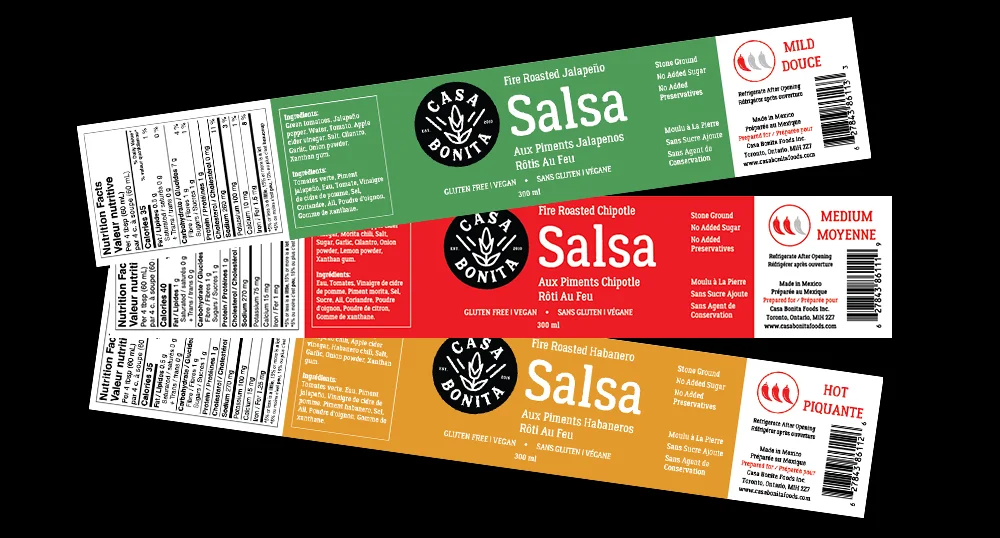Let’s be honest, running a food or beverage brand in Canada is a full-course meal. Between ingredient sourcing, perfecting your packaging, managing supply chains, and growing your audience, compliance can sometimes feel like the side dish you didn’t order—until it’s the one thing that throws your entire launch off track.
But here’s the deal: compliance is not a buzzkill. It’s a launchpad. When done right, it builds consumer trust, keeps you retail-ready, and helps your product stand out in a crowded aisle (yes, even beside that overly aesthetic granola brand).
At NOVO MxC, we work with food and beverage businesses across Canada to bring their brands to life with bold strategy, scroll-stopping packaging, and yes—labels that check all the boxes (literally and legally). Whether you’re just starting out or scaling up, here’s everything you need to know about food regulations in Canada—and how to serve compliance with a side of creativity.
🧂 Section 1: Food Safety & Labeling – It’s What’s on the Outside and Inside That Counts
If your product’s packaging is the first impression, then the label is the legal handshake. Canada’s Food and Drug Regulations (FDR) and Safe Food for Canadians Regulations (SFCR) are the big players here, covering everything from nutrition facts to bilingual requirements, ingredient transparency, best-before dates, and more.
Miss even one small detail and your product might be pulled off shelves—or never make it there in the first place.
Here’s what to watch out for:
- Allergens: The top priority. You must clearly list priority allergens like peanuts, milk, gluten, and shellfish—or risk facing major recalls.
- Bilingual Labeling: If your product is being sold anywhere in Canada (especially Quebec), both English and French must be present.
- Nutrition Panels: Using an outdated or misformatted Nutrition Facts Table? That’s a no-go. Formatting and serving sizes must meet the Canadian Food Inspection Agency (CFIA) guidelines.
- Ingredient Clarity: Words like “flavours” or “spices” can get you flagged unless they’re clearly explained.
⚡ Actionables:
✅ Get your label copy reviewed by someone familiar with CFIA requirements
✅ Use the Canadian Food Inspection Agency (CFIA) online Label Tool as a reference
✅ Always print proofs and check bilingual accuracy before hitting mass production
Don’t just make a label—make it work for you. A well-designed, compliant label doesn’t just avoid legal risk—it increases customer trust and retail acceptance.
🌱 Section 2: Organic & Non-GMO Certification – Clean Labels, Strong Claims
Organic and non-GMO claims are hot commodities in today’s conscious consumer market. But unlike trends, these require hard evidence and official certifications to back them up.
In Canada, any product labeled “organic” must be certified by a CFIA-accredited body under the Canadian Organic Standards (COS). This isn’t just a matter of switching to organic ingredients—it’s about following strict practices throughout your supply chain, from soil to shelf.
When it comes to non-GMO, Canada doesn’t have a national regulation—but any claim must still comply with general truth-in-advertising laws. Most brands opt for third-party validation (like Non-GMO Project Verified) to gain consumer trust.
Big compliance mistakes to avoid:
- Using the word “organic” without certification
- Marketing “natural” or “clean” claims in a misleading way
- Forgetting that imported organic ingredients must meet Canadian standards
🍏 Actionables:
✅ Choose a certification body early in your product development process
✅ Document everything—sourcing, cleaning methods, batch records
✅ Use certification seals properly (they have sizing and placement rules!)
Bonus tip: Highlighting your organic or non-GMO story in your branding and packaging can elevate your shelf appeal—just make sure the legal story and the brand story match.
💬 Section 3: Health Claims & Advertising – Say What You Mean (and Prove It)
You want to tell the world your beverage boosts energy, supports immunity, or helps with digestion—but did you know that even subtle health claims are heavily regulated?
Canada separates claims into two main types:
- Nutrient function claims (e.g., “Iron helps transport oxygen throughout the body”)
- Risk reduction claims (e.g., “A healthy diet rich in fruits and vegetables may reduce the risk of some types of cancer”)
To make any of these legally, your product has to contain enough of the right nutrients, follow Health Canada’s pre-approved statements, and meet very specific thresholds. Even social media captions, influencer partnerships, or customer testimonials can fall under scrutiny if they imply medical or functional benefits.
Real talk:
- You can’t use vague phrases like “gut-friendly” unless your product supports a real, approved claim
- “Boost” or “detox” language can raise red flags unless backed by data
- Your ad copy and your label copy must be in sync
📋 Actionables:
✅ Consult Health Canada’s list of approved claims before launching campaigns
✅ Avoid making medical claims unless you’ve done your homework (and clinical studies)
✅ Train your marketing team on compliant language—creative doesn’t mean careless
Think of it this way: your brand should excite your audience, not regulators.
Conclusion: Let’s Get You Compliant and Compelling
There’s no denying that Canadian food and beverage regulations are complex—but they don’t have to be overwhelming. When you build your brand with compliance in mind from the start, it becomes a competitive advantage, not a barrier.
That’s where we come in.
At NOVO MxC, we help food brands like yours grow from startup to shelf-ready to cult-favourite. We make sure your brand looks good, speaks clearly, and follows every guideline along the way. Whether you’re navigating a product launch, rebrand, or expansion, we help you blend creativity with compliance—seamlessly.
Our services include:
- Strategy – Knowing your audience, and how to reach them legally and creatively
- Branding – Crafting a story that builds trust and connection
- Packaging Design – Labels that sell and satisfy Canadian Food Inspection Agency (CFIA) standards
- Website Design – Beautiful, accessible platforms that inform and convert
- Food Photography – Showcasing your product in its best light
- Video Production – Telling your story through sight, sound, and flavor
- Animation – Making your message move and stick
So, whether you’re just getting your first product ready for market, or preparing for a major rebrand with new claims and certifications—we’re here to help you serve up your best work.🍽️ Please give us a call at 416-892-2471 or reach out to us using the contact form at the bottom of this page.




